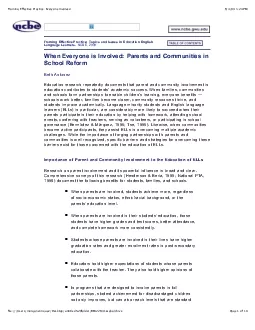

1991 andthe positive impact of such partnerships is well documented Gargiulo Graves1991 Espinosa 1995 Research specifically suggests that schools of the futuremust be restructured with the assistance ID: 884104
Download Pdf The PPT/PDF document "events conferring with teachers serving ..." is the property of its rightful owner. Permission is granted to download and print the materials on this web site for personal, non-commercial use only, and to display it on your personal computer provided you do not modify the materials and that you retain all copyright notices contained in the materials. By downloading content from our website, you accept the terms of this agreement.
1 events, conferring with teachers, servin
events, conferring with teachers, serving as volunteers, or participating in schoolgovernance (Bermdez & Mrquez, 1996; Tse, 1996). Likewise, when communitiesbecome active participants, they assist ELLs in overcoming multiple academicchallenges. While the importance of forging partnerships with parents andcommunities is well recognized, specific barriers and strategies for overcoming thesebarriers exist for those conce
2 rned with the education of ELLs. Impor
rned with the education of ELLs. Importance of Parent and Community Involvement to the Education of ELLsResearch on parent involvement and its powerful influence is broad and clear.Comprehensive surveys of this research (Henderson & Berla, 1995; National PTA,1998) document the following benefits for students, families, and schools. 1991) andthe positive impact of such partnerships is well documented (Gargiulo & Graves
3 ,1991; Espinosa, 1995). Research specifi
,1991; Espinosa, 1995). Research specifically suggests that schools of the futuremust be restructured with the assistance of the business sector and the communityat large (U.S. Department of Education, 1992). However, restructuring will beeffective only if it includes acknowledgement of barriers and specific strategies toaddress the needs and promote the involvement of these important players in theeducational process.
4 Barriers to Parent and Community Invol
Barriers to Parent and Community Involvement among ELL PopulationsOften, language and/or cultural barriers prevent parents from feeling confident in setting are less likely to be on their studentsÕ behavior and learning styles. It is theeducatorÕs obligation to learn as much about the culture andbackground of their students as possible.Outreach efforts need not be limited to parents. Schools can identify and accessco
5 mmunity organizations able to provide op
mmunity organizations able to provide opportunities for out-of-school experiencesthat enrich childrenÕs lives. These organizations can keep children safe, mobilizeneeded services, and provide children with opportunities for productive use of freetime. In neighborhoods that are rich with resources, it is taken for granted thatchildren will be exposed to opportunities for experiential learning, travel, recreation,and expe
6 riencing the arts. When ELLs lack opport
riencing the arts. When ELLs lack opportunities to be exposed tocommunity resources - because of language, financial, or cultural barriers - CBOsare in a position to make deliberate and concerted efforts to provide these 16(Summer): 1-16.Delgado-Gaitn, C. (1991, November). Involving parents in theschools: A process of empowerment. American Journal of Education,100 (1), 20-46.Eccles, J.S., & Harold, R.D. (1996). Family
7 involvement in children andadolescentsÕ
involvement in children andadolescentsÕ schooling. In A. Booth and J.F. Dunn, (Eds.) Family-school links: How do they affect educational outcomes? (pp. 3-34).Mahwah, NJ: Lawrence Erlbaum Associates.Epstein, J. L. (1992). School and family partnerships. In M. Alkin (Ed.),Encyclopedia of Educational Research, Sixth Edition. New York, NY:MacMillan.Epstein, J. L., & Dauber, S. L. (1991). School programs and teacherpractice
8 s of parent involvement in inner-city el
s of parent involvement in inner-city elementary and middleschools. Elementary School Journal, 91, 289-305.Espinosa, L. (1995). Hispanic parent involvement in early childhoodprograms. Champlain, IL: ERIC Clearinghouse on Elementary andEarly Childhood Education.Gargiulo, R. M., & Graves, S. B. (1991). Parent feelings. ChildhoodEducation, 67(3), 176-178.Garca, D.C. (1990). Creating parent involvement: A manual for school
9 children and parents interacting program
children and parents interacting program. Miami, FL. Florida University,School of Education. (ERIC Document Reproduction Service No. ED323 273).Gonzlez, L.A. (1992). Tapping their language: A bridge to success.The Journal of Educational Issues of Language Minority Students, 10,27-39.Henderson, A. T., & Berla, N. (1994). A new generation of evidence:The family is critical to student achievement. Washington, DC: National
10 Committee for Citizens in Education.Inge
Committee for Citizens in Education.Inger, M. (1992, August). Increasing the school involvement ofHispanic parents. (EDO-UD-92-3). ERIC Clearinghouse on UrbanEducation, 80, 1-2.Keith, T. Z., & Keith, P. B. (1993). Does parent involvement affecteighth-grade student achievement? Structural analysis of national data.School Psychology Review, 22 (3), 474-496.Kirst, M. (1991). Improving childrenÕs services. Phi Delta Kappan,